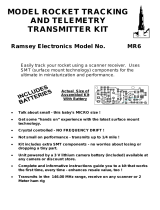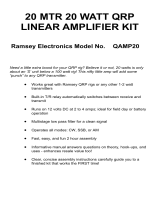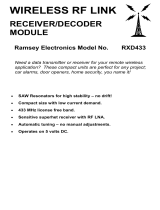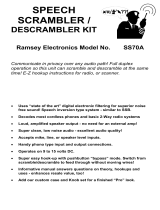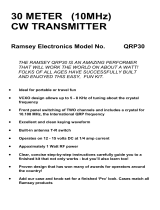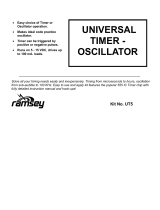Page is loading ...

AA7 • 1
ALL BAND HF, VHF, UHF
ACTIVE ANTENNA
Ramsey Electronics Model No. AA7
• Great for perking up scanner reception.
• Dual preamp HF-VHF/UHF front panel switching.
• Circuit based on true active antenna research.
• Performance rivals units costing many times more!
• Front panel RF gain control.
• Uses Dual Gate MOSFET technology for low noise HF amplification,
and a high gain microwave transistor for VHF/UHF.
• Includes internal telescopic whip antenna plus auxiliary antenna
input jack for jazzing up existing antennas.
• Clear, concise assembly instructions carefully guide you to a
finished kit that works FIRST time!
• Informative manual answers questions on theory, hookups and
uses - enhances resale value, too!
• Ideal companion to any Ramsey receiver.
• Power switch cuts the AA7 active antenna in and out of the antenna
line with no need to change cables.
• Runs on a standard 9 volt battery!
Stuck for antenna space? Don’t want to string any more wires?
This ACTIVE ANTENNA KIT gives you roof-top performance on
a desk top!

AA7 • 2
PARTIAL LIST OF AVAILABLE KITS
RAMSEY TRANSMITTER KITS
• FM10, FM25B FM Stereo Transmitters
• FM100 Super Pro FM Transmitter
• MR6 Model Rocket Tracking Transmitter
• AM1, AM25 AM Transmitters
RAMSEY RECEIVER KITS
• FR1 FM Broadcast Receiver
• AR1 Aircraft Band Receiver
• SR2 Shortwave Receiver
• HFRC 10 MHz WWV Receiver
• SC1 Shortwave Converter
RAMSEY HOBBY KITS
• SG7 Personal Speed Radar
• SS70A Speech Scrambler
•TG1 DTMF Tone Grabber
• BS1 “Bullshooter” Digital Voice Storage Unit
• AVS10 Automatic Sequential Video Switcher
• WCT20 Cable Wizard Cable Tracer
• MD3 Microwave Motion Detector
• ML Music Lights Kit
• LC1 Inductance-Capacitance Meter
RAMSEY AMATEUR RADIO KITS
• HR Series HF All Mode Receivers
• QRP Series HF CW Transmitters
• CW7 CW Keyer
• QRP Power Amplifiers
RAMSEY MINI-KITS
Many other kits are available for hobby, school, scouts and just plain FUN. New
kits are always under development. Write or call for our free Ramsey catalog.
AA7 ACTIVE ANTENNA KIT INSTRUCTION MANUAL
Ramsey Electronics publication No. MAA7 Revision E
First printing: August, 1994
COPYRIGHT
1994 by Ramsey Electronics, Inc. 590 Fishers Station Drive, Victor, New York
14564. All rights reserved. No portion of this publication may be copied or duplicated without the
written permission of Ramsey Electronics, Inc. Printed in the United States of America.

AA7 • 3
AA7 ACTIVE
ANTENNA KIT
Ramsey Publication No. MAA7
Manual Price Only: $5.00
TABLE OF CONTENTS
Introduction to the AA7 ............................................. 4
Circuit and Device Description .................................. 4
Active Antennas: Circuits With a Purpose ................ 5
Parts List ................................................................... 6
Assembly Instructions ............................................... 7
Schematic Diagram .................................................. 8
Parts Layout Diagram ............................................... 9
Initial Tests ................................................................ 12
Using your AA7 ......................................................... 12
Troubleshooting Guide ............................................. 13
Active Antenna Comparisons ................................... 14
The AA7’s Enclosure ................................................ 14
A Final Suggestion .................................................... 14
Ramsey Kit Warranty ................................................ 15
KIT ASSEMBLY
AND INSTRUCTION MANUAL FOR
RAMSEY ELECTRONICS, INC.
590 Fishers Station Drive
Victor, New York 14564
Phone (585) 924-4560
Fax (585) 924-4555

AA7 • 4
INTRODUCTION TO THE AA7
We believe that you will discover and agree with us that your new AA7 is
the best VALUE in a true receiver antenna. In its simplest form, an “active
antenna” is a small antenna going through an RF preamplifier to a receiver.
Generally, the actual antenna may be of several different styles:
• broad-band (no tuning required)
• fixed-tuned (i.e., pre-set for a specific frequency)
• variable-tuning (permits peaking or “pre-selecting” a variety of band
choices)
It is easy to assume that the “ideal” active antenna would peak your
desired signal or frequency band. Several excellent active antennas are
available for this purpose in the $75 - $150 price range, but we would point
out that using this kit plus an additional $1 in mini coax to approximate your
antenna will work as well, or even better. In our humble opinion, if you really
want to spend that much money, you’re better off spending an extra five
dollars and buying a good quality receiver. (Study the Ramsey HR-series or
our SR-1 shortwave receiver, and you will see how easy that idea can really
be!)
If what you want is a great quality active antenna for a whole lot less than
others sell it for, the answer is obvious. The Ramsey AA7 active antenna.
An active antenna is a compromise between what is ideal... and what is
real. Real antennas are wire or tubing properly measured in meters, not
transistors or variable capacitors. If you find yourself in a difficult antenna
situation for casual listening or monitoring, we think that you’ll get more
satisfaction from understanding and using your AA7 than from wishing that
you spent your money on a tunable model would result in a real antenna!
CIRCUIT AND DEVICE DESCRIPTION
The AA7 features two independent, switchable RF preamplifiers. The HF
(high frequency) section is located on the upper middle section of the
schematic on page 6, while the VHF (Very High Frequency) / UHF (Ultra
High Frequency) section is located on the lower middle section.
Simple switching circuits play a major role in the practical use of the AA7.
S2:B connects the RF input and output connectors in the “power off”
position. This gives the receiver non-amplified access to the auxiliary
antenna jack, as well as the on-board rod antenna. With S2 in its “power on”
position, S1 selects between the two independent antenna amplifier
configurations (HF or VHF).

AA7 • 5
The dual-gate MOSFET amplifier circuit (Q1), selected with S1 in the “out”
position is designated the HF preamp circuit, due to the exceptionally low
noise level of its operation. This is ideal for enhancing weak CW-SSB
signals. This amplifier performs the true “active antenna” function of the
AA7.
The 2SC2498 amplifier circuit (Q2), selected with S1 in the “in” position, is
designated the VHF preamp circuit, due to the excellent VHF (very high
frequency) and microwave (baked-potato frequency) response
characteristics of the 2SC2498. With the on-board whip antenna adjustable
for peak resonance throughout the VHF- UHF region (Wavelength [ft.] = 234/
f [MHz] - terribly long for a baked potato), this mode of the AA7 is ideal for
indoor, outdoor and portable use of VHF scanners and other receivers.
Both modes are usable for HF, while the 2SC2498 offers higher gain but
also a higher noise level. The user can easily choose either amplifier for
copying any signal of interest. The front panel gain control (R5) is usable
with either amplifier.
ACTIVE ANTENNAS: CIRCUITRY WITH A PURPOSE:
There is more to a true active antenna than any old preamp or preselector
hooked to a piece of wire.
The AA7 was designed with reference to research carried out by Ulrich L.
Rohde and T.T.N. Bucher, who co-authored Communications Receivers:
Principals and Design (New York: McGraw-Hill Book Company). Rohde also
shares credit for the highly sophisticated Rohde-Schwarz Type HE010
10KHz-80MHz Active Antenna. The book illustrates how proper design of a
broadband active antenna can give receiver performance very comparable to
a quarter-wave vertical ("passive antenna") for a given frequency. The
book's footnotes cite considerable study by professionals on the optimum
design of active antennas.
A short rod antenna, such as the whip supplied with your AA7, "receives"
signals from the whole radio spectrum. Hence if you were to connect it
directly to the antenna connection of your HF SWL receiver or antenna
connection, you may not be impressed. The reason is not so much that the
antenna is too short, or not resonant, but that its performance is all but
shorted-out by the receiver, which is “looking for” a more conventional
antenna.
A well-designed broadband active antenna considers field strength of the
desired signal (measured in microvolts per meter of antenna length),
atmospheric and other noise, diameter of the antenna, radiation resistance
and antenna reactance at various frequencies, plus the efficiency and noise

AA7 • 6
figure of the amplifier circuit which amplifies the signal from the antenna rod
before it gets to the receiver's RF input.
We mention these things, with no need to get into a lot of engineering
detail, just to let you know that "Active Antennas" are a serious topic among
contemporary receiver designers, and that we did our homework in bringing
you the economical AA7.
AA7 ACTIVE ANTENNA KIT PARTS LIST
Please verify that the following items are present before starting assembly.
CAPACITORS
1 100 pF disc capacitor (marked 100 or 101) [C3]
4 .01 µF disc capacitor (marked .01, 103 or 10nF) [C1, C2, C5, C6]
1 4.7 µF to 10 uF electrolytic capacitor [C4]
RESISTORS
1 100 ohm (brown-black-brown) [R4]
2 100K ohm (brown-black-yellow) [R3, R6]
1 220K ohm (red-red-yellow) [R2]
1 1M ohm (brown-black-green) [R1]
1 10K ohm PC mount potentiometer [R5]
SEMICONDUCTORS
1 Dual gate MOSFET transistor (4 pins) [Q1]
1 2SC2498 or 2570 NPN VHF transistor [Q2]
CONTROLS AND HARDWARE
2 DPDT push switches [S1, S2]
2 PCB- mounted RCA jacks [J1, J2]
1 9 volt battery hold-down clamp
1 9 volt battery snap connector
1 Telescoping whip antenna with mounting screw
REQUIRED, NOT SUPPLIED
1 9 volt battery (alkaline or heavy-duty)
OPTIONAL
1 Ramsey case and knob kit, or your own enclosure
1 LED “power on” indicator and 1K ohm resistor
1 External antenna terminated in RCA-type plug
REQUIRED TOOLS
Soldering Iron (Radio Shack #RS64-2072)
Thin Rosin Core Solder (RS64-025)

AA7 • 7
Needle Nose Pliers (RS64-1844)
Small Diagonal Cutters (RS64-1845)
ADDITIONAL SUGGESTED ITEMS
Soldering Iron Holder/Cleaner (RS-64-2078)
Holder for PC Board/Parts (RS64-2094)
Desoldering Braid (RS-2090)
ASSEMBLY INSTRUCTIONS
The following assembly steps are given in accord with the LEARN-AS-
YOU-BUILD philosophy for Ramsey Kits. To the extent that is reasonably
possible, parts are installed in the order of signal flow as depicted on the
schematic diagram, with some discussion of the components whenever
useful.
Because the AA7 is of great interest to people who simply enjoy shortwave
listening and VHF monitoring, experienced ham operators should understand
that our instructions are addressed to people for whom this may be their very
first electronic kit project.
First Assembly Steps
Perform all assembly on a suitable surface which will not be damaged by
hot solder. A cardboard box, cut so that it is flat tends to work well if you do
not have such a surface conveniently available. Always use caution
operating and storing a hot soldering iron. We like to live under a nifty motto
here at Ramsey that we think you will agree with (or will come to agree
with!). “A hot soldering iron looks just the same as a cold soldering iron.”
Trust me... it’s true.
Since you may appreciate some "warm-up" soldering practice as well as a
chance to put some "landmarks" on the AA7 PC-board, we first will install
some "hardware" components, to make the up-down, left-right orientation of
the PC board as clear as possible.
In ALL of the following instruction steps, our word "INSTALL" means to do
the following:
• Insert the part, oriented correctly, into its correct holes in the PC-board.
• If helpful, gently BEND the part's wire leads or tabs to hold it into place,
with the body of the part snugly against the top side ("component side")
of the PC-board. The top side is the side that does not contain metal
traces, but does have an outline of each part printed on it.

AA7 • 8

AA7 • 9
AA7 PARTS LAYOUT DIAGRAM

AA7 • 10
• SOLDER ALL wires or pins of the part, whether the 2 wires of a
resistor or the 3 or 4 wires of a transistor.
• Trim or Nip all excess wires extending beyond each solder connection,
taking care that wire trimmings do not become lodged in PC-board
solder connections.
Soldering the AA7 Printed Circuit Board
1. Install J1, the RF input jack. Notice that it is connected directly to the
screw hole for the extendable whip antenna. Solder all 4 points of the
jack secure!
2. Install S1, one of the two push switches. Position it so that the
plunger of the switch extends over the edge of the PC board. It fits
correctly only one way and is on the same side of the board as J1, which
you have already installed. Notice that this switch selects which
preamplifier circuit will be used. We'll wire the VHF circuit path first,
because it's a little easier. Solder all six points of the switch.
3. Install C3, 100 pf. immediately behind S1.
4. Install R6 100K [brown-black-yellow] next to C3. NOTE: Save the
extra wires nipped away from C3, R6 and similar parts. You will use
them to make jumper wires.
5. Notice that Q2, the 2SC2498 transistor is installed with the flat side
facing the rear (antenna and receiver jacks) of the PC-board. Press the
transistor gently but firmly into it three holes so that the exposed wire
leads are as short as possible. Carefully solder all three leads on Q2.
6. Using a scrap component lead wire, install jumper wire 2 (JMP2) near
S1. This connects the preamp that is selected by S1 to the coupling
capacitor for the receiver jack.
7. Similarly, install JMP1. (This connects the J2 receiver jack directly to
J1 and the whip antenna when S2 is in the out or off position.
8. Install R4, 100 ohms [brown-black-brown].
9. Install C6, .01 µF. which couples the output of the selected
preamplifier path to the J2 receiver jack.
10. Install C2, .01 µF. When S1 is in the "out" or HF position, C2
couples the RF input to the Dual gate MOSFET preamplifier you are
about to build.
11. Install R1, 1 megohm [brown-black-green].
12. Install R2, 220K ohms [red-red-yellow].
13. Install C1, .01 µF.

AA7 • 11
14. Install R3, 100K [brown-black-yellow].
15. If you have completed Steps 4 through 14 correctly, you now have
the 4 holes for Q1 surrounded by other parts, making it easy to find!
Examine Q1, the dual-gate MOSFET. The schematic diagram shows
why it has 4 leads. Insert Q1 so that the square tab is pointing directly at
JMP2, but... DO NOT solder Q1's 4 leads until you are satisfied that the
tab is oriented as explained, and that the 4 wires are in the respective
holes without any twisting. Just as for Q2, keep Q1`s wires as short as
possible. Solder all four leads of Q1.
16. Insert RF gain control R5 into the PC board, make sure it is seated
securely. Solder the three pins and the two mounting tabs.
17. Install C5, .01 µF.
18. Install C4, the polarized electrolytic capacitor. Electrolytic capacitors
have polarity and must be installed properly. The negative side of the
capacitor is marked with a black stripe with negative sides. The PC
board or the parts layout diagram will show the correctly labeled (+) sign
next to the positive hole. Be sure to use the correct polarity.
19. Install S2, which controls DC power and also connects the antenna
jack, J1, and the receiver jack, J2, directly together when in the turned
“off” position. Solder all six points of the switch.
20. Install receiver jack J2. Solder all four points of the jack.
21. Install the battery snap connector (WITHOUT the battery for now,
please). Make sure the positive (red) and negative (black) wires are
connected in the correct holes. This PC board follows the accepted
standard that the red wire denotes the positive hole (+) and the black
wire denotes the negative (-) hole.
22. Install the battery hold-down clamp using a scrap component lead
wire placed through the two holes in the clamp and into the PC-board
holes. Pull the wire tight and then solder it firmly to the two PC-board
points and to the clamp itself (on the top side of the PC board.) Be sure
not to use too much solder on the clamp as it may keep the battery from
sitting flat and securely in the clamp.
23. Using the mounting screw supplied, attach the whip antenna to its
position on the PC-board. The whip antenna should point up from the
component (top) side with the screw inserted through the bottom.
Tighten it firmly to ensure a good electrical connection, don’t force it so
hard that you break it or the PC board and it’s delicate traces. You may
wish to lightly sand the plating from the screw head and solder it to the
PC-Board.

AA7 • 12
24. BEFORE connecting battery or conducting any tests, PLEASE
recheck each of the preceding steps, looking especially for:
• quality of solder connections
• correct orientation of Q1 and Q2
• correct orientation of the electrolytic C4
• correct battery wire polarity
• correct values for resistors and capacitors
INITIAL TESTS
No adjustments or alignment is required. See the following section about
preparing a reliable and convenient cable for the AA7 and your receiver as
well as an optional add-on antenna.
Testing the AA7 consists of turning it on, using it and checking that all its
described features are operational. You will need to become accustomed to
the signal strength in the highest range of the gain control. If you experience
any problem, consult the Trouble-Shooting Hints section of this book.
USING YOUR AA7
For some of our kits, this "USING...." section becomes the longest part of
the book, depending on the possible applications of the kit product. What is
very nice about the AA7 is that using it is simple, enjoyable and immediate.
We have two suggestions that will increase your enjoyment of the AA7 right
from the beginning:
1. Prepare a reliable coaxial cable with the right connectors to run from
the antenna input of your receiver or scanner to the RF output of the
AA7 (RCA male plug required). If you do not have them at hand, a visit
to Radio Shack should easily get you what you need.
2. Make a simple "supplementary portable antenna" of any design which
is practical for YOU. Use a small-diameter coaxial cable neatly
terminated in a male RCA male plug to mate J1. This antenna can be a
dipole, or random wire with earth ground or counterpoise, a bigger
vertical whip of some kind, a Slinky, or even a pair of alligator clips at the
end of your coax line, ready to be clipped to any large metal surface that
may be handy, from screen doors to bed springs! This accessory for
your AA7 will help you explore the truth of "Ramsey's Antenna Rule" in a
variety of travel situations: "If you want more signal, put up more metal!”
A Caution to Ham, Maritime and CB Operators:
If you are using the AA7 to boost reception on a transceiver of any kind,

AA7 • 13
rather than only a receiver or scanner, make sure it is not possible to transmit
by accidentally pressing a mike button or CW keyer. Transmitted RF into the
AA7 is likely to ruin one or both of the transistors.
Transistor Placement Information:
Both transistors may be ordered from Ramsey Electronics, but they also may
be found at a local electronics parts distributor. You may use either "SK" or
"ECG" replacements:
3N201 = ECG454 or SK3991
2SC2498 = ECG10 or SK9139
LED Power On Indicator
A visual power on indicator can be an enjoyable and practical enhancement
of your completed kit. LEDs (Light Emitting Diodes) are available at low cost
and are ideal for this purpose, providing you don't mind the extra current drain.
Voltage for a standard LED is easily taken from the appropriate top terminal of
S2. The switched +9V terminal is the middle of three terminals in the row
nearest the center of the PC board. This positive DC must be connected to the
anode (longer wire) of the LED. The cathode lead is connected through a
proper current limiting resistor of about 1K ohm to the closest PC-board ground
point. (Note: This can be locations such as the black wire of the battery, the
mounting case of either jack, but it CANNOT be the antenna.) Mount the LED
at any convenient point near the switch.
TROUBLESHOOTING GUIDE
The fact that there are two independent preamplifiers makes the AA7 easier
to diagnose than many other devices. If a problem occurs only when S1 is
pressed inward, troubleshooting can be concentrated on that part of the circuit.
If the problem is common to both settings, then the components and
connections common to both preamps should be checked. Make sure you
have not omitted any of the jumper wires required.
There are other characteristics or phenomena associated with preamplifiers
and active antennas which do NOT mean that your AA7 is malfunctioning:
Strong AC hum in the HF setting:
The antenna is too close to an AC cord or
power line, and/or the RF gain is set too high.
HF signals stronger at VHF than at HF setting:
As explained in the AA7
circuit description, either preamp may be used for HF. Signal strength will be
greater with the VHF preamp, but the HF signal-to-noise ratio should be better
with the dual gate MOSFET HF section.

AA7 • 14
Unusual oscillations in receiver: Some portable receivers not enclosed in
metal cases may break into oscillation when connected to any RF
preamplifier. Try reducing the AA7 gain control and make sure good
grounds are on the interconnecting coax cables.
Receiver overloading, heterodynes, images:
A preamplifier will intensify
any problems with selectivity and image rejection due to poor receiver
design.
ACTIVE ANTENNA COMPARISONS
The author of this AA7 instruction manual has conducted extensive side-
by-side comparisons of the AA7 with the Heathkit HD-1424 and MFJ
Enterprises, Inc. Model 1020A active antennas, both of which have band-
switched tunable preamplifiers as well as an understandably higher selling
price. If all three units are compared, each using only its on-board whip
extended to equal heights, the two tunable units do produce a stronger
signal. We would hope so! However, attaching about two more feet of wire
to the AA7's whip resulted in it delivering the strongest signal. Similarly,
increasing the antenna lengths of the other units resulted in increased signal
strength. It becomes a question of how much you wish to pay for the shortest
possible indoor antenna! The AA7's competition performs well, but we are
sure you will appreciate the AA7's versatility and budget pricing.
THE AA7'S ENCLOSURE: THE FINISHING TOUCH
The Ramsey Electronics custom case, panel and knob kit is optional for
the AA7 as it is for all of our standard major PC-board kits. In it’s case, the
finished AA7 will be attractive and virtually indestructible, so that the world of
radio can be at your fingertips wherever you go. Use of our factory enclosure
also enhances the resale value of your AA7.
A FINAL SUGGESTION
A small antenna is most effective whenever it can be outdoors and clear of
any surrounding metal building structure. You may wish to use a mix of
personal ingenuity and hardware store/junk-box parts to make a simple
remote whip that can be quickly mounted on windows, windowsills, balcony
rails, or handy points on cars, RVs, etc. We hope you will enjoy your AA7 in
a wide variety of listening and monitoring situations.
Kit building is FUN! Ramsey has a wide variety of nifty kits. Ask for our free
catalog, where there are plenty more kits ideally suited for you!

AA7 • 15
The Ramsey Kit Warranty
Please read carefully BEFORE calling or writing in about your kit. Most problems can be solved
without contacting the factory.
Notice that this is not a "fine print" warranty. We want you to understand your rights and ours too! All
Ramsey kits will work if assembled properly. The very fact that your kit includes this new manual is
your assurance that a team of knowledgeable people have field-tested several "copies" of this kit
straight from the Ramsey Inventory. If you need help, please read through your manual carefully, all
information required to properly build and test your kit is contained within these pages! However,
customer satisfaction is our goal, so in the event that you do have a problem, take note of the
following.
1. DEFECTIVE PARTS: It's always easy to blame a part for a problem in your kit, however, customer
satisfaction is our goal, so in the event that you do have a problem, take note of the following. Before
you conclude that a part may be bad, thoroughly check your work. Today's semiconductors and
passive components have reached incredibly high reliability levels, and its sad to say that our human
construction skills have not! But on rare occasion a sour component can slip through. All our kit parts
carry the Ramsey Electronics Warranty that they are free from defects for a full ninety (90) days from
the date of purchase. Defective parts will be replaced promptly at our expense. If you suspect any part
to be defective, please mail it to our factory for testing and replacement. Please send only the
defective part(s), not the entire kit. The part(s) MUST be returned to us in suitable condition for testing.
Please be aware that testing can usually determine if the part was truly defective or damaged by
assembly or usage. Don't be afraid of telling us that you 'blew-it', we're all human and in most cases,
replacement parts are very reasonably priced.
2. MISSING PARTS: Before assuming a part value is incorrect, check the parts listing carefully to see
if it is a critical value such as a specific coil or IC, or whether a RANGE of values is suitable (such as
"100 to 500 uF"). Often times, common sense will solve a mysterious missing part problem. If you're
missing five 10K ohm resistors and received five extra 1K resistors, you can pretty much be assured
that the '1K ohm' resistors are actually the 'missing' 10 K parts ("Hum-m-m, I guess the 'red' band
really does look orange!") Ramsey Electronics project kits are packed with pride in the USA. If you
believe we packed an incorrect part or omitted a part clearly indicated in your assembly manual as
supplied with the basic kit by Ramsey, please write or call us with information on the part you need and
proof of kit purchase.
3. FACTORY REPAIR OF ASSEMBLED KITS:
To qualify for Ramsey Electronics factory repair, kits MUST:
1. NOT be assembled with acid core solder or flux.
2. NOT be modified in any manner.
3. BE returned in fully-assembled form, not partially assembled.
4. BE accompanied by the proper repair fee. No repair will be undertaken until we have received the
MINIMUM repair fee (1/2 hour labor) of $25.00, or authorization to charge it to your credit card
account.
5. INCLUDE a description of the problem and legible return address. DO NOT send a separate letter;
include all correspondence with the unit. Please do not include your own hardware such as non-
Ramsey cabinets, knobs, cables, external battery packs and the like. Ramsey Electronics, Inc.,
reserves the right to refuse repair on ANY item in which we find excessive problems or damage due to
construction methods. To assist customers in such situations, Ramsey Electronics, Inc., reserves the
right to solve their needs on a case-by-case basis.
The repair is $50.00 per hour, regardless of the cost of the kit. Please understand that our technicians
are not volunteers and that set-up, testing, diagnosis, repair and repacking and paperwork can take
nearly an hour of paid employee time on even a simple kit. Of course, if we find that a part was
defective in manufacture, there will be no charge to repair your kit (But please realize that our
technicians know the difference between a defective part and parts burned out or damaged through
improper use or assembly).
4. REFUNDS: You are given ten (10) days to examine our products. If you are not satisfied, you may
return your unassembled kit with all the parts and instructions and proof of purchase to the factory for a
full refund. The return package should be packed securely. Insurance is recommended. Please do not
cause needless delays, read all information carefully.

AA7 • 16
AA7 ACTIVE ANTENNA
Quick Reference Page Guide
Introduction to the AA7 .....................................4
Circuit and Device Description ..........................4
Active Antennas: Circuits With a Purpose ........5
Schematic Diagram ..........................................6
Parts Layout Diagram .......................................7
Parts List ...........................................................8
Assembly Instructions .......................................9
Using your AA7 .................................................12
Troubleshooting Guide .....................................13
Active Antenna Comparisons ...........................14
Ramsey Kit Warranty ........................................15
Manual Price Only: $5.00
Ramsey Publication No. MAA7
Assembly and Instruction manual for:
RAMSEY MODEL NO. AA7 ACTIVE ANTENNA KIT
REQUIRED TOOLS
• Soldering Iron (WLC100)
• Thin Rosin Core Solder (RTS12)
• Needle Nose Pliers (MPP4 or RTS05)
ADDITIONAL SUGGESTED ITEMS
• Helping Hands Holder for PC Board/Parts
(HH3)
• Technician’s Tool Kit (TK405)
• Desoldering Braid (RTS08)
TOTAL SOLDER POINTS
63
ESTIMATED ASSEMBLY
TIME
Beginner .............. 2 hr
Intermediate ........ 1 hr
Advanced ............ 30 min.
RAMSEY ELECTRONICS, INC.
590 Fishers Station Drive
Victor, New York 14564
Phone (585) 924-4560
Fax (585) 924-4555
www.ramseykits.com
/

